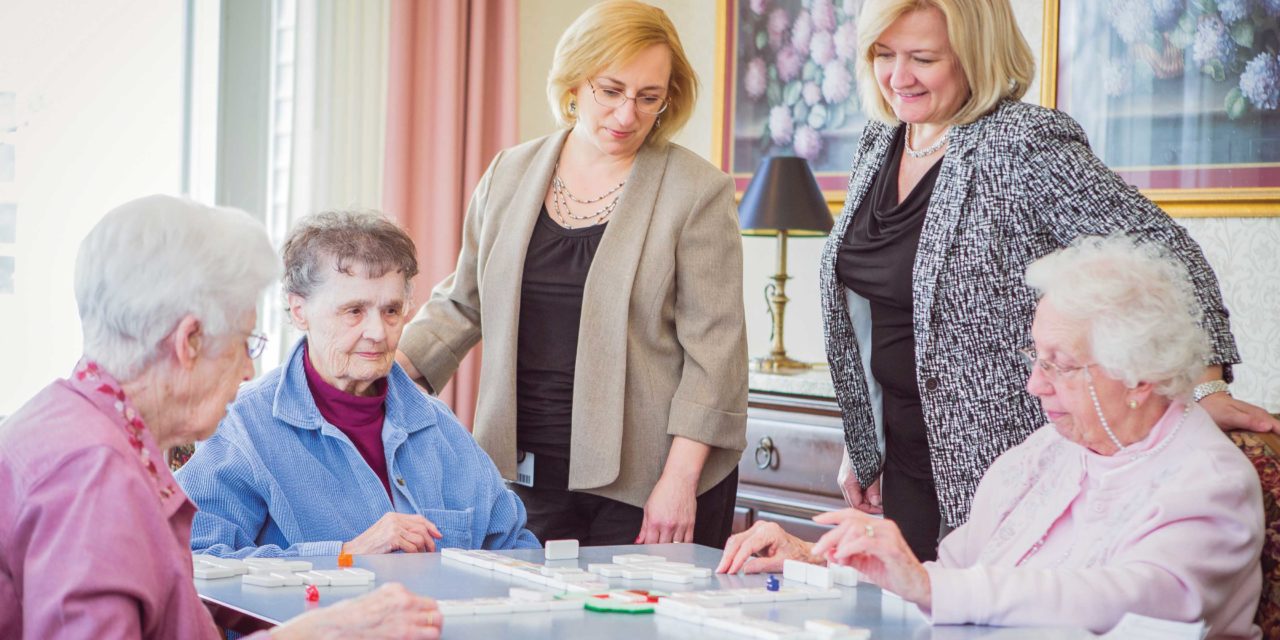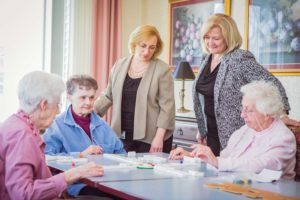SPECIAL SECTION: AGING WITH GRACE
by Lisa Moody Breslin, photography by Kelly Heck
When it snows, the phones ring off the hook at Carroll Lutheran Village.
Older residents in the county are looking up the long walk that winds from their driveway to the front door; they’re thinking about ice that might be forming in the gutters and, at some point, it hits them: Uncle. Not another season.
“It’s a good sign. The folks who are the most successful are ready for the move,” said Lisa Albin, Director of Church and Public Relations at Carroll Lutheran Village. “Because they are ready, they will not only be happy to join the community, but they are also more likely to enjoy the activities and the new community of friends. They often become volunteers, or go back to college – whatever interests them.”
Albin and representatives from the 36 other assisted living places in the county are part of what one older Carroll County resident called a “harmonious network of options.”
So when older residents and/or their caregivers are ready to explore housing that matches their lifestyle, health and financial needs, they can, and should, shop around.
The list of options includes modifying the existing home, moving to a housing facility with more support and social options, joining a network of like-minded people to share specialized services, or moving to a retirement community where a majority of the residents are over the age of 65, or even a nursing home.
Consider it Mission Goldilocks. If one option doesn’t seem to fit, try another. And then explore another until you know you are making a change that is just right.
Mission Goldilocks, ideally, should not involve multiple moves, many caution.
“Ask yourself if the new space will accommodate you as you age?” said Jill Rosner, an aging life care expert. “If you have some health issue in the future, will you be able to stay there or will you have to make another move? Are there steps that may become difficult? Is there a bedroom and a full bathroom with a walk-in shower on the first floor?”
“Look five or 10 years into the future and consider what kind of place will be best for the long-term,” advised Lauren Hickey, Community Relations Director for Right at Home. “Is it a smaller home, a 55+ community, senior apartments, an assisted living situation, or a continuing care retirement community? You don’t want to be forced to make multiple moves.”
“We gave a lot of thought to it,” said David Scott, who along with his wife, Carole, is independent living residents at Carroll Lutheran Village. “We wanted to be in a community, a secure place, where people cared about each other.”
Access to good hospitals, nearby shopping, dining and entertainment were all important factors they considered, Carole said. Carroll County satisfied those conditions.
“We have a son and grandchildren in the Baltimore-Towson area, which of course was a very good reason for us wanting to be in this area.” Carole said.
They also have a new family member, an 11-week-old golden retriever, named Baird.
Hickey and many others highly recommend The Carroll County Bureau of Aging and Disabilities as a great starting point. The Bureau has a resource guide that details all the options in the county. The bureau also helps connect seniors to the right options and resources to meet their unique needs.
Older residents don’t have to be haunted by the three of the four most common fears: they will run out of money; they will be placed to rot in crummy nursing home; someone, perhaps even their children, will steal their money; they will be lonely.
Reality can be just the opposite, explained Gina Valentine, who has worked with the bureau of aging and disabilities since 2007, and is currently the services supervisor.
“In fact, there is a broad spectrum of free, or Medicaid-funded, services and programs available to help them stay in their homes as long as possible, to help them meet needs they can’t meet on their own financially,” Valentine added. “But navigating the options can be difficult and frustrating. That’s why we are here to help.”
The Community First Choice program and Community Options waiver are two popular programs available to older residents who hope to remain in their communities. (See Resources list, Page 73).
When Dahl Drenning, a pastor at Trinity Lutheran Church, took his mother to a care facility, he remembers riding the elevator on his way out and listening to someone else describe the woes of moving a family member.
“She stepped in and just unloaded about all the care, worry, anxiety linked to the move,” Drenning said. “And at that moment, I thought, ‘People should not have to go through this. They don’t have to re-invent the wheel each time a family emergency comes up.’ “
Drenning knew there were resources available that could be investigated. He knew that most of the time, when older people move, it involved reacting to an emergency.
He wanted more people to be proactive rather than reactive.
And that is the message he shares with his congregation, often.
“While you are healthy, alert and competent, make decisions about where and how you want to live.” Drenning said. “Ideally, you want to make your own decision, not have a unilateral decision made by someone else. It is a tremendous gift to take that pressure off your children or other family members.”
Drenning and his siblings helped their mother, Katherine, age in her own place as long as possible. As her health declined, he and his siblings responded accordingly. They worked well together, he said.
“It was a positive thing, we divided the labor. One sibling was good at legal and financial things; another was great at making phone calls and making arrangements. I was the one who spent time talking to her and holding her hand. It was all important for her care and well-being.”
In retrospect, even Drenning, said they could have been more proactive rather than reactive. “It’s important to realize that even the best made plans don’t always work out.”
“You’ll always able to look back without regret, with peace of mind that comes with knowing that you did all that you could have. Ideally, you remain on he same page as your loved one, but that’s not always possible, let alone easy. But you want to know you did your best and the best involves planning proactively.”
Reporters Anne Blue and Jeffrey Roth contributed to this article.


